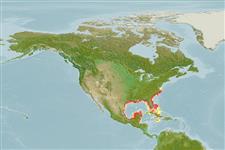Classification / Names
आम नाम | उपशब्द | Catalog of Fishes(वर्ग, प्रजाति) | ITIS | CoL | WoRMS | Cloffa
Environment: milieu / climate zone / depth range / distribution range
पारिस्थितिकी
समुद्री; स्वच्छ जल, अलवण जल; खारा ड़िमरसल; गहराई सीमा 2 - 25 m (Ref. 55207), usually 2 - 6 m (Ref. 55207). Subtropical; 39°N - 17°N, 100°W - 75°W (Ref. 55207)
Western Atlantic: Chesapeake Bay to southern Florida in the USA and the Gulf of Mexico. Records from South America doubtful (Ref. 7251).
Length at first maturity / आकार / वज़न / Age
Maturity: Lm 22.0, range 22 - 23 cm
Max length : 61.0 cm WD पुल्लिंग / अलिंग; (Ref. 6902); common length : 27.0 cm WD पुल्लिंग / अलिंग; (Ref. 6902); common length :39 cm WD (female); अधिकतम प्रकाशित वज़न: 4.9 kg (Ref. 40637)
Prominent triangular snout. Broadly rounded outer corners of disc. Upper surface brown or yellowish brown, paler toward margins of disc. Lower surface white (Ref. 6902). Few scapular spines. Middorsal row of spines present, but few on tail beyond pelvic fins (Ref. 7251).
Adults inhabit coastal waters, including estuaries and lagoons (Ref. 12951) and ascend rivers (Ref. 12951). They feed on tube anemones, polychaete worms, small crustaceans, clams, and serpent stars (Ref. 12951). Ovoviviparous (Ref. 50449). Parturition occurs in July and August (Ref. 27549). Litters of 2-3 pups; gestation 4 months (Ref. 114953).
Life cycle and mating behavior
परिपक्व अवधि | पुनरुत्पत्ति | मछलीऔ का अंडे देना | अंडे | Fecundity | लार्वा
Exhibit ovoviparity (aplacental viviparity), with embryos feeding initially on yolk, then receiving additional nourishment from the mother by indirect absorption of uterine fluid enriched with mucus, fat or protein through specialised structures (Ref. 50449). Distinct pairing with embrace (Ref. 205).
Robins, C.R. and G.C. Ray, 1986. A field guide to Atlantic coast fishes of North America. Houghton Mifflin Company, Boston, U.S.A. 354 p. (Ref. 7251)
IUCN Red List Status (Ref. 130435: Version 2024-1)
Threat to humans
Harmless
Human uses
मात्स्यिकी: कोई रुचि बग़ैर
साधन
Special reports
Download XML
इंटरनेट स्रोत
Estimates based on models
Preferred temperature (Ref.
123201): 23.2 - 27, mean 25.5 °C (based on 272 cells).
Phylogenetic diversity index (Ref.
82804): PD
50 = 0.5039 [Uniqueness, from 0.5 = low to 2.0 = high].
Bayesian length-weight: a=0.00468 (0.00195 - 0.01123), b=3.12 (2.92 - 3.32), in cm total length, based on LWR estimates for this (Sub)family-body shape (Ref.
93245).
Trophic level (Ref.
69278): 3.5 ±0.42 se; based on food items.
लौटाव (Ref.
120179): बहुत नीचे, न्यूनतम जनसंख्या दुगनी समय अवलागत 14 महीने। (K=0.26-0.31; Fec assumed <10).
Fishing Vulnerability (Ref.
59153): Very high vulnerability (90 of 100).
Nutrients (Ref.
124155): Calcium = 15.8 [2.1, 309.7] mg/100g; Iron = 0.739 [0.068, 8.595] mg/100g; Protein = 22.3 [20.0, 24.4] %; Omega3 = 0.199 [0.062, 0.591] g/100g; Selenium = 14.8 [2.7, 68.8] μg/100g; VitaminA = 6.9 [0.6, 69.4] μg/100g; Zinc = 0.726 [0.053, 8.530] mg/100g (wet weight); based on
nutrient studies.
